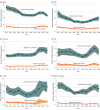Antimicrobial-Resistant Infections in Hospitalized Patients
- PMID: 40085086
- PMCID: PMC11909612
- DOI: 10.1001/jamanetworkopen.2024.62059
Antimicrobial-Resistant Infections in Hospitalized Patients
Abstract
Importance: Antimicrobial resistance is a major public health problem in the US. Estimating national rates of antimicrobial-resistant infections commonly associated with health care can aid in targeted public health efforts.
Objective: To determine the national incidence rates of 6 pathogens over time: methicillin-resistant Staphylococcus aureus (MRSA), vancomycin-resistant Enterococcus spp (VRE), extended-spectrum cephalosporin-resistant Escherichia coli and Klebsiella spp (excluding Klebsiella aerogenes) (ESCR-EK), carbapenem-resistant Enterobacterales (CRE), carbapenem-resistant Acinetobacter spp (CRAsp), and multidrug-resistant (MDR) Pseudomonas aeruginosa.
Design, setting, and participants: This cohort study used data from 2012 to 2022 on inpatient hospitalizations, clinical cultures, and facility-level characteristics. Hospital-months were included in the dynamic cohort if the hospital reported at least 1 culture with microbial growth accompanied by antimicrobial susceptibility testing (AST) results in the month. Data from the PINC-AI and Becton Dickinson Insights databases were used, and cases were defined as incident nonsurveillance cultures yielding an organism of interest with sufficient AST results for a phenotype of interest. Data were collected from January 2012 to December 2022 and analyzed from April 2023 to June 2024.
Exposure: Inpatient hospitalizations with a discharge date in an included hospital month.
Main outcomes and measures: National annual antimicrobial-resistant cases per 10 000 hospitalizations were obtained using weights based on facility-level characteristics. Cases were defined as community-onset if collected on or before day 3 of hospitalization and hospital-onset if obtained on day 4 or later.
Results: This study cohort included 332 to 606 hospitals per year between 2012 to 2022 and 7 158 139 cultures. Antimicrobial-resistant pathogens accounted for an estimated 569 749 (95% CI, 475 949-663 548) cases and 179.6 (95% CI, 163.1-196.1) cases per 10 000 hospitalizations in 2022. Of these cases, 77% (437 657; 95% CI, 364 529-510 785) were community-onset and 23% (132 092; 95% CI, 108 241-155 943) were hospital-onset. MRSA (44% [251 854; 95% CI, 209 558-294 150]) and ESCR-EK (35% [200 884; 95% CI, 163 692-238 077]) made up the largest proportions of total infections in 2022, respectively. Rates of hospital-onset MRSA, VRE, CRE, CRAsp, and MDR P aeruginosa had periods of decline from 2012 to 2019; however, all pathogens experienced an increase in hospital-onset rates in 2020 and 2021. Community-onset ESCR-EK rates increased from 2012 to 2022, while community-onset rates of MRSA, VRE, and MDR P aeruginosa declined.
Conclusions and relevance: While antimicrobial resistance rates have experienced uneven declines in the US from 2012 to 2022, the burden of resistance remains substantial. These findings suggest that more effective strategies to reduce antimicrobial resistance are needed.
Conflict of interest statement
Figures



References
-
- Centers for Disease Control and Prevention . Antibiotic resistance threats in the United States, 2013. Accessed January 17, 2025. https://www.cdc.gov/antimicrobial-resistance/media/pdfs/ar-threats-2013-...
-
- Centers for Disease Control and Prevention . Antibiotic resistance threats in the United States, 2019. Accessed January 17, 2025. https://www.cdc.gov/antimicrobial-resistance/media/pdfs/2019-ar-threats-...
-
- WHO bacterial priority pathogens list, 2024: bacterial pathogens of public health importance to guide research, development, and strategies to prevent and control antimicrobial resistance. World Health Organization. Accessed January 17, 2025. https://iris.who.int/bitstream/handle/10665/376776/9789240093461-eng.pdf...
Publication types
MeSH terms
Substances
LinkOut - more resources
Full Text Sources
Medical
Research Materials
Miscellaneous

